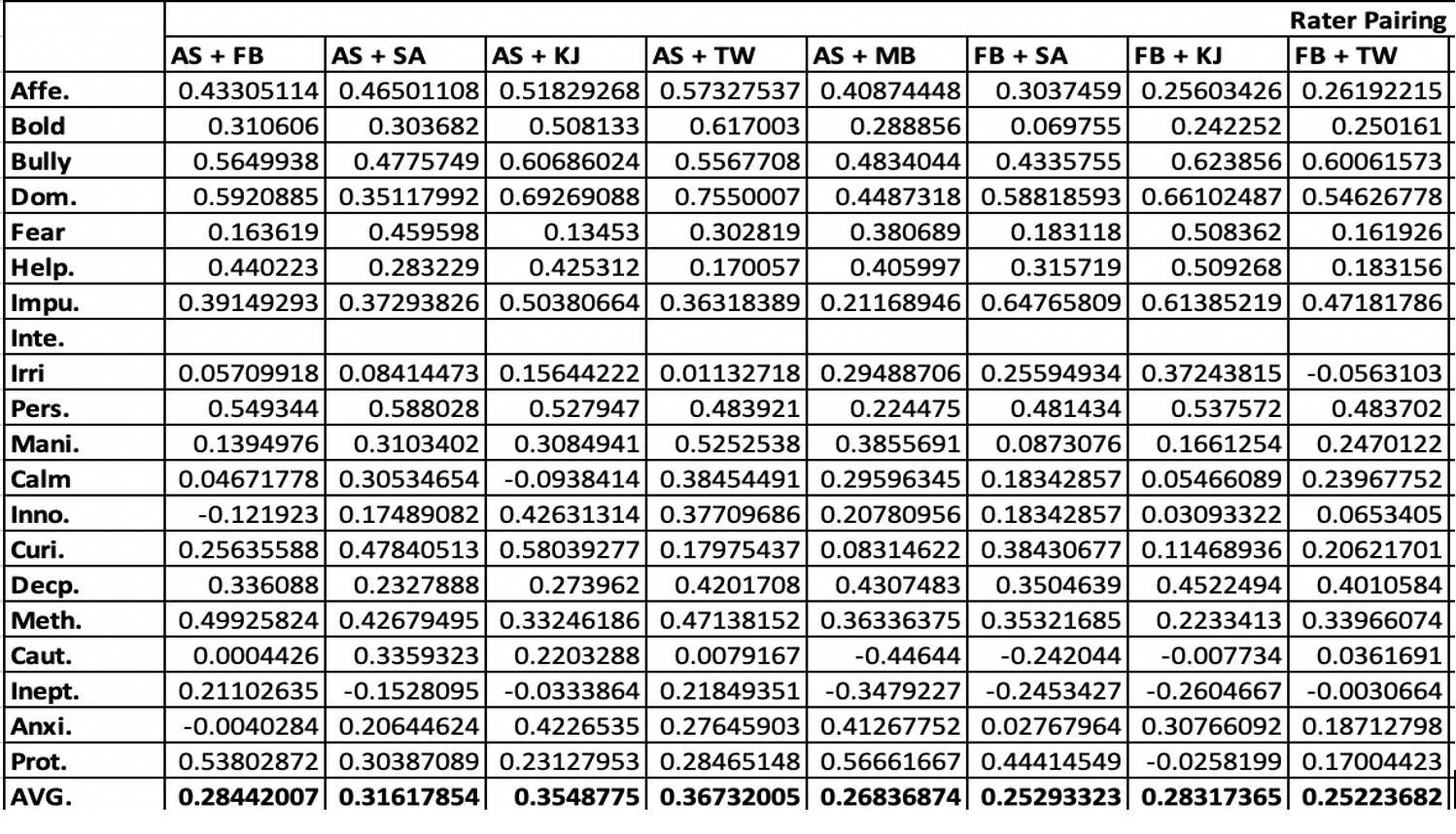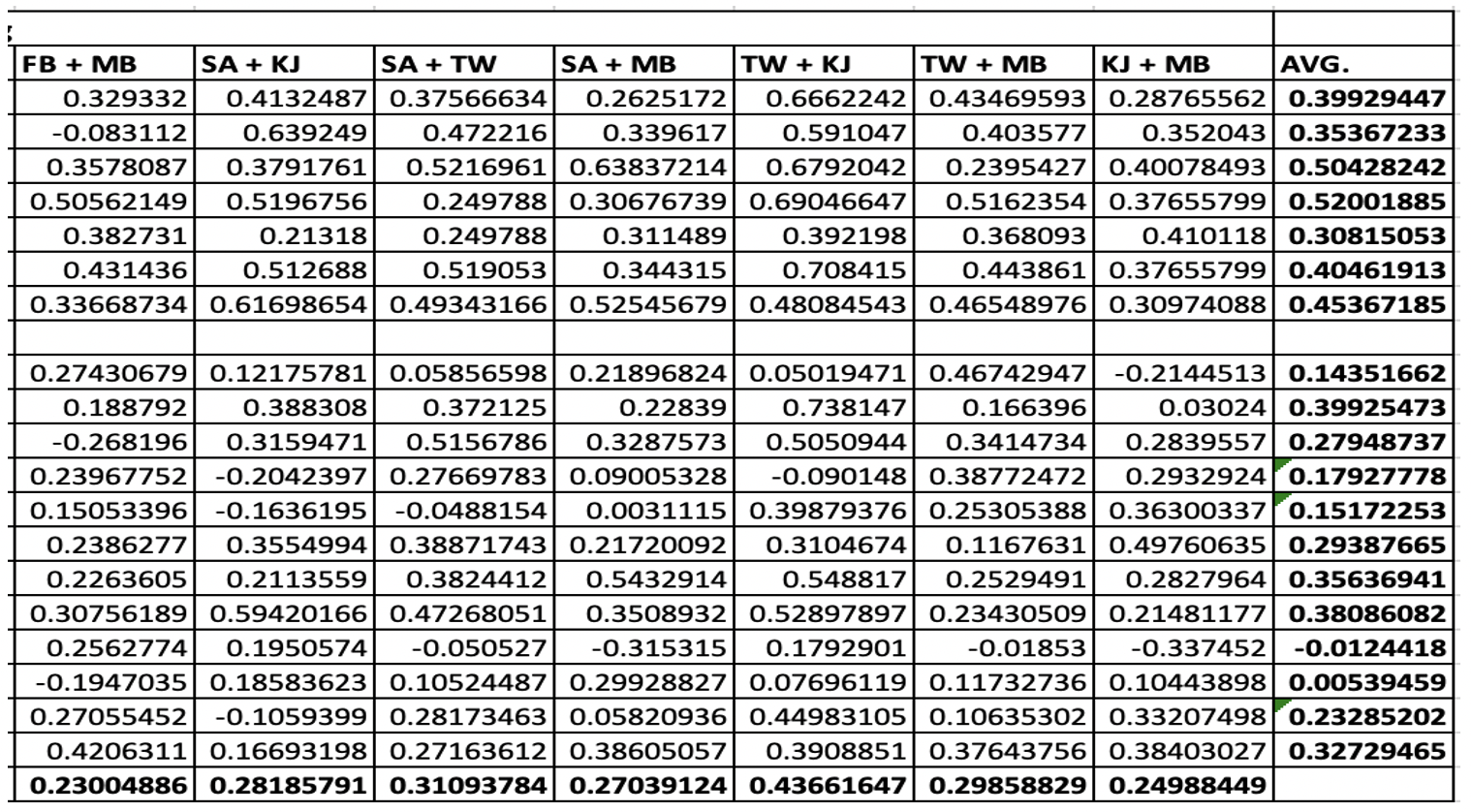Comparing Wild. vs. Rescued Chimpanzee Personality Part One: Organizing Data
Comparing Wild. vs. Rescued Chimpanzee Personality
Part One: Organizing Data
Alexa Pil
Department of Biology, Tufts University
Laidlaw Foundation Research Project
Professor Zarin Machanda
September 12, 2023
Abstract
This experiment seeks to compare the personality of wild and captive chimpanzees using personality data from two sites: Kibale National Park (wild) and Ngamba Island Chimpanzee Sanctuary (captive). A literature review of chimpanzee personality studies is summarized as well as important information integral to the development of this research. The coefficient of determination, R^2 values were determined for the Kibale chimpanzee data to determine the reliability of raters and personality adjectives. Based on the R^2 values, adjectives with correlations under 0 were not included in the study. Therefore, cautiousness was excluded due to its average R^2 value of -0.0124418. The inability to calculate R^2 values for intelligence necessitates further analyzation of the data from the adjective. Lastly, further implications of this study and the next steps to take are discussed.
Introduction
This study began with a literature review of recent studies on chimpanzee personality, the evolution of personality, and broader animal personality. For animals with shorter life spans, current research focuses on life-history tradeoffs - exploring how differing personalities may be linked to different adaptive strategies.(McElreath et al., 2007) For example, a cautious personality vs. a bold personality: an animal with a cautious personality will avoid current danger to benefit from future reproductive benefits, while an animal with a bold personality will be more prone to current danger but experience greater opportunities to reproduce now. (McElreath et al., 2007)(Wolf et al., 2007) For animals with longer life spans, such as chimpanzees, this theory is not as applicable, because individuals would be able to update their reproductive strategies as the values of reproduction changed over time (Weiss et al., 2023) Many facets of chimpanzee personality are studied, such as the relationship between personality traits and longevity, personality traits and rank attainment, or sex differences in personality. Through these studies, the methods by which to analyze the given personality data was determined and the necessary background information by which to compare the found results was explored.
Methods
The data used in this study is from the Kibale Chimpanzee project, which studies the Kanyawara chimpanzee population located in the Kibale National Park in Uganda. Researchers from all over the world have studied the Kanyawara chimpanzees since 1987.(Thompson et al., 2020). They are one of the largest habituated populations. Data collected is comprised of focal follows (following one individual and recording interactions/actions for a set amount of time), physiological measurements (urine, feces, physical growth), and several other metrics.(Thompson et al., 2020) This study focused on data from personality questionaries administered to field assistants working at KCP. All field assistants included in this collection of data had been working at the KCP for over two years. The questionnaire consisted of twenty adjectives with a description of the adjective, and a scale from 1 (least) to 7 (most) on which to rate the chimpanzee on that adjective. Additionally, at the end of the questionnaire, field assistants were asked to rate which chimpanzee was the least and most characteristic of four traits: helpful, irritable, fearful, and bullying. Data was collected on 66 chimpanzees and field assistants only rated chimpanzees that they knew well enough. Six field assistants were chosen to complete the questionnaire. Each chimpanzee was given its own ID based off its given name. The data was then organized in excel in two ways: in Version A of the questionnaire, chimp IDs were ordered randomly by a random number generated. Version B is ordered in reverse to Version A.

- Included to the left is the first page of the questionnaire mentioned.
- A second page with ten more adjectives was also included.
- This questionnaire was completed by each of six raters for all the 66 chimpanzees that they were familiar with.
Analyzing the Data
Analyzing the data began with calculating R^2, the coefficient of determination between each pair of raters for every personality trait. Calculating this measure allows for an understanding of how similar the ratings are per chimp for each set of raters. This measure was important to calculate to determine if any adjectives resulted in very mixed ratings, or if any raters were seemingly unreliable compared to their counterparts across all the ratings. To calculate R^2 using excel, the data needed to be sorted into columns of two by chimp ID for each pair of raters. Because Versions A and B were organized in opposite fashions, sorting this data by eye was time consuming. While the first three raters’ data was collected using Version A and so could be compared seamlessly, the last three raters needed to be reorganized to fit each rater of Version A. Once this step had been completed, the correlation could be calculated for each pair.
Chart 1:
Chart 1 displays the first half of the R^2 calculations chart, as well the first half of averages of R^2 values for raters. The data for intelligence was not included because it was not calculable due to one rater describing every chimpanzee as 7. R^2 values could not be calculated when all of one column was the same number.
Chart 2:

Chart 2 displays the second half of the R^2 value chart, as well as the second half of averages at the bottom, and the average R^2 per adjective for each rating.
*note: this data table was split in half in order to make viewing easier. Full table is included below.
Based on the R^2 values, adjectives with correlations under 0 should not be included in the study. Therefor, cautiousness should be excluded due to its average R^2 value of -0.0124418 Further analysis will be conducted to use the intelligence data. Possibly excluding data from the field assistant that rated all chimpanzees as 7 (most).
After conclusions on the accuracy of the adjectives/raters, several statistical analyses will be conducted to explore this personality data further. First, interrater reliability must be calculated using a correlation coefficient. Second, the mean rating for each chimpanzee must be calculated across rater to perform an exploratory factors analysis, or principal components analysis to group adjectives into personality dimensions, which can then be compared more easily. (Weiss et al., 2017)(King & Figueredo, 1997) All these steps will be repeated for data from the Ngamba Island Chimpanzee Sanctuary in order to compare these two data sets as originally planned.
Next Steps to take
To complete the analysis of this data, R must be learned through a series of Primate Data Modules form Michigan University. After analyzing the Kibale data in full, the sanctuary data must be organized and analyzed, as well as a method developed to compare across these two data sets. A further review of current research must be conducted to learn about the effects of captivity on primates to from a basis for conclusions of this study. Differences in lifestyle between wild vs. sanctuary chimpanzees must be explored to frame any results from the data analysis. Captivity will need to be defined, and eligibility criteria for captive chimpanzee personality data must be determined.
Impacts of Further Research
Comparing captive vs. wild chimpanzee personality has implications for chimpanzee conservation, and the evolution of complex personality in mammals. The purpose of this study of chimpanzee personality is to understand personality phenotypes which are most common in wild populations to evaluate chimpanzees in sanctuaries for similar personality traits necessary for release. Understanding such differences in wild vs. captive chimpanzee personality can also help to better understand how captive environments effect chimpanzees and ways to improve these environments. Further studies may also try to determine what aspects of captivity have effects on personality. For example, how does food security, a ready access to a stable food source effect chimpanzee personality and dominance structure?
Bibliography
King, J. E., & Figueredo, A. J. (1997). The Five-Factor Model plus Dominance in Chimpanzee Personality. Journal of Research in Personality, 31(2), 257–271. https://doi.org/10.1006/jrpe.1997.2179
McElreath, R., Luttbeg, B., Fogarty, S. P., Brodin, T., & Sih, A. (2007). Evolution of animal personalities. Nature, 450(7167), E5–E5. https://doi.org/10.1038/nature06326
Thompson, M. E., Muller, M. N., Machanda, Z. P., Otali, E., & Wrangham, R. W. (2020). The Kibale Chimpanzee Project: Over thirty years of research, conservation, and change. Biological Conservation, 252, 108857. https://doi.org/10.1016/j.biocon.2020.108857
Weiss, A., Feldblum, J. T., Altschul, D. M., Collins, D. A., Kamenya, S., Mjungu, D., Foerster, S., Gilby, I. C., Wilson, M. L., & Pusey, A. E. (2023). Personality traits, rank attainment, and siring success throughout the lives of male chimpanzees of Gombe National Park. PeerJ, 11, e15083. https://doi.org/10.7717/peerj.15083
Weiss, A., Wilson, M. L., Collins, D. A., Mjungu, D., Kamenya, S., Foerster, S., & Pusey, A. E. (2017). Personality in the chimpanzees of Gombe National Park. Scientific Data, 4(1), 170146. https://doi.org/10.1038/sdata.2017.146
Wolf, M., Van Doorn, G. S., Leimar, O., & Weissing, F. J. (2007). Life-history trade-offs favour the evolution of animal personalities. Nature, 447(7144), 581–584. https://doi.org/10.1038/nature05835
Please sign in
If you are a registered user on Laidlaw Scholars Network, please sign in